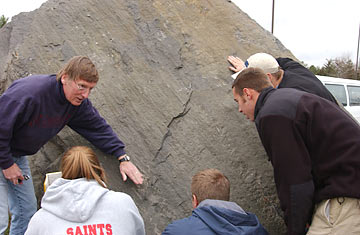Table of Contents
Turn Left in Bismarck, and Go Until…
Rocking Our World
Relax! We Have New Labs for That
Fieldwork Across the Curriculum:
Update on ISEI
Letter from James Costopoulos '83
Rocking Our World
Associate Professor and Chair of Geology John Bursnall explains a geological principal using one of the University's new outdoor lab specimens as an illustration. One day last July, two huge boulders landed on campus. They were not delivered by glaciers, as many so-called “erratics” were several thousand years ago, nor did they come crashing down in flames from outer space. They arrived on flatbed trucks. Tipping the scales at 35 tons and 45 tons respectively (the larger one caused two tire blowouts on the 20-mile ride from its ancestral home at a road construction site), the one-billion-year-old behemoths are the first outcrops for the Dolan Outdoor Geology Laboratory.
Project director John Bursnall, associate professor and chair of geology, explains the laboratory, whose creation is funded by a grant from the Dolan Family Foundation. Explaining that hands-on field experience early in students’ introduction to the geological sciences provides a much more secure foundation for the more advanced courses that follow, he says, “The outdoor ‘laboratory’ will provide real three-dimensional examples of what students are learning conceptually in the classroom.”
The Dolan Outdoor Geology Laboratory, Bursnall explains, will eventually consist of 12 to 15 artificially created rock outcrops of varying sizes that are strategically located across campus “to represent a variety of geological relationships and structure. They will be arranged specifically to represent a particular but imaginary subsurface distribution that students will be able to survey and map,” he says.
Besides proximity, Bursnall says one advantage of the lab is that it “will be used throughout the geology curriculum,” from the introductory to advanced levels. “These rock outcrop installations will challenge students progressively as their understanding and skills develop,” he notes. “Students will discover for themselves via multiple working hypotheses the stories that these artificial arrangements portray, including the three-dimensional (and fourth dimensional, when geological time is included) nature of the imaginary subsurface geology that these outcrops have been intentionally placed to represent.” --NSB
